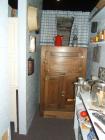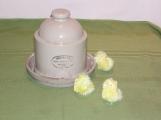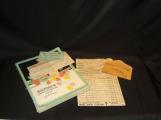14
The homemaker would peruse the seed catalogue, planning next summer's garden.16
In late winter - labour intensive - were the putting up ice for another water source and/or having a supply of ice for ice box for summer refrigeration. They would be cut with big ice saws. The chunks would be about 3 feet wide, 4 feet long and about 2 feet thick. They would be stored in a building in sawdust or in grain in a granary.18
The ice was used for refrigeration in summer. The block of ice was placed in the upper compartment and the food in the lower. The cost was $7.26 in the 1895 Montgomery Ward catalogue.20
SPRING:Ordering seeds for a large garden, which also could also be purchased in the T. Eaton catalogue.
22
Buying chicks to increase the flock that had been depleted for meat in late fall. This feeding station was for special grounded grain.24
Grandma, you always had young chicks in the farm yard. Tell me how you looked after this.Answer:
Every spring when a laying hen sat on eggs and started to cluck usually meant that she was ready to brood. We would set up a nest with a dozen fertilized eggs in a quiet and darkend area.
To do this, one had to be careful and quietly cover her up in late evening and carry her to this nest. She may be upset for a little while but once she felt the eggs under her she would quickly settle down to incubate these eggs.
One had to make sure that there were enough water and feed for her. After 21 days the chick would begin to hatch. In a day or so they also needed water and food. The best protein feed was chopped boiled eggs to give them a good start. One had to be careful not to let them loose too soon as there was a danger from farm cats, fox, skunks etc.
With in a week they were ready to be placed in a pen for their security.






